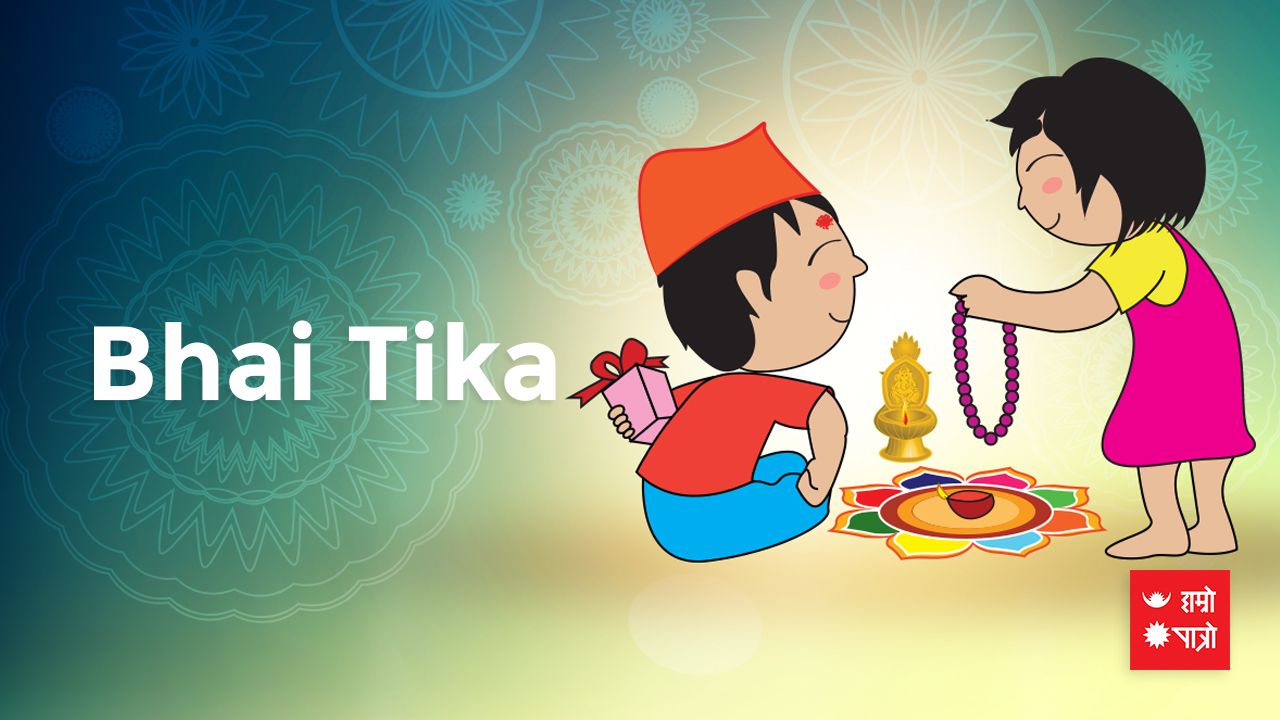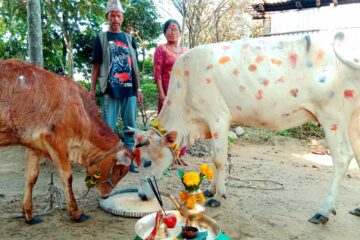Bhai Tika is celebrated on the last (fifth) day of Tihar festival by worshiping brothers and sisters for long healthy life and protection from evil.
Why is Bhai Tika Celebrated?
Bhai Tika is celebrated in honor of the enduring connections between brothers and sisters. During the celebration, sisters worship brothers for their long and healthy life.
Myths of Bhai Tika?
Here are different versions of myths behind the celebration of Bhai Tika in Nepal.
First, Once upon a time there was a girl called Yamuna who had a very ill brother. One day while Yamuna was worshiping for the health of her brother, Yama (god of death) visited her house to take the soul of her brother. But before taking the soul, Yamuna asked Yama to take part in the puja (worship).
And Yama got impressed with the Yamuna’s worship and asked for a boon (wish) from him. And Yamuna asked for the healthy long life of her brother which was granted by Yama and saved the life of Yamuna’s brother.
Second myth is that there was a Kirati King called Bali Hang who fell mortally ill and his sister, Jamuna took care of him . And when Yamraj (god of death) came to take the soul of King Bali, his sister asked Yamraj to wait till she finishes worshiping her brother.
Yamraj agreed, and while worshiping her brother, Jamuna set some conditions. The conditions were until the tika on Bali’s head faded away, until the Makhamali (Gomphrena globosa) garland flower wilted, the water smeared on her brother’s body dried, or the barrier she made with oil around her brother evaporated, Yamaraj cannot take her brother.
So, each year Yamaraj would send his messengers to inspect the Makhmali flowers, but the flowers would not wilt. Hence Yamaraj granted Bali a long healthy life. For this reason, sisters worship their brothers during Tihar.
According to the third myth, Yama and Yamuna were brother and sister. And since Yama was the god of death, he was always busy and Yamuna couldn’t meet him. So, Yamuna used a crow, a dog, and a cow to send a message to Yama, stating that she wanted to meet him. Still, Yama could not meet her sister.
So, on the fifth day, Yamuna went to Yama herself and met her brother. She then put a five-color tika on Yama’s forehead. So, from this day onwards, Tihar has been celebrated.
How is Bhai Tika Celebrated?
The puja starts with sisters marking around the brothers with oil dipped in lemon grass or dubo. This barrier is created to stop death and other evil spirits from crossing this line.
Then Sisters apply oil on the hair and ear of their brothers, put Tika of five different colors (Red, White, Yellow, Blue and Green) on the forehead, then put the flower garlands (Marigold and Makhamali flower) on the neck, offer delicious foods like sweets, cakes, and many other nepali food items.
And Brothers similarly put Tika and flower garlands on Sisters, and also give gifts and cash.
All together, they have a feast of delicious foods, dance and sing with the family.
In case if a boy does not have a sister, they can receive it from their father’s sister as well.
Also to those siblings who do not have brothers or sisters visit Ranipokhari Temple in Kathmandu, and they put or receive tika there. Hindus believe that no one’s forehead should be without tika on this day.
Ranipokhari Temple is open to the public only on Bhai Tika.
Meaning Behind Special Items Used in Bhai Tika
Masala in Bhai Tika
During Bhai Tika, nuts and spices like Walnut, Almond, Pistachio, Cardamom, Cloves and many more. It’s called Masala (Bhai Masala) and given by sisters to their brothers and vice versa after putting/receiving tika.
These items are enriched with nutrients and their consumption is important for brain’s health. They also give energy. Thus there is the tradition of giving Masala in Bhai Tika.
Citrus Fruits like Bimir and Bhogate
During Laxmi Puja and Bhai Tika, Bimiro (Citrus fruit like lemon) is used. And in the Newari community Bhogate (Pomelo) is used.
In Hindu Mythology, Bimiro has its own significance. Yamraj (god of death) and his sister Yami like Bimiro. So this fruit symbolizes them and is thus worshiped.
Also since Bhogate and Bimiro are citrus fruits, they are vital to our health and immune system.
When is Bhai Tika in Nepal?
Bhai Tika generally falls in the Nepali month of Kartik (October/November) and comes after a few weeks of Dashain.
This year Bhai Tika is on 3rd November, 2024 (18th Kartik, 2081 B.S.).
Bhai Tika is also celebrated as Bhai Dooj in Northern Part of India, Bhai Ponta in West Bengal, Bhai Junita in Odisha, Bhau Beej in Indian states of Maharashtra, Goa, Gujarat and Karnataka, Bhatru Dviteeya in Andhra Pradesh and Bhatri Ditya or Bhaghini Hastha Bhojanamu in Telangana, India.
What is the auspicious time for Bhai Tika this year?
The auspicious time for Bhai Tika this year is as follows
- Kathmandu (6th Kartik 2082) – 11:39 am on Thursday, October 23
- Wellington, New Zealand – Yet to be confirmed
- Delhi, India (23 October, 2025) – 01:13 PM to 03:28 PM
- Lisbon, Portugal – Yet to be confirmed
- New York, USA – Yet to be confirmed
- London, UK – Yet to be confirmed
- Frankfort, Kentucky, USA – Yet to be confirmed
- Paris, France – Yet to be confirmed
- Wovensboro, Kentucky, USA – Yet to be confirmed
- Oslo, Norway – Yet to be confirmed
- Dallas, Texas, USA – Yet to be confirmed
- Kuala Lumpur, Malaysia – Yet to be confirmed
- Washington DC, USA – Yet to be confirmed
- Abu Dhabi, UAE – Yet to be confirmed
- California, USA – Yet to be confirmed
- Doha, Qatar – Yet to be confirmed
- Toronto, Canada – Yet to be confirmed
- Bangkok, Thailand – Yet to be confirmed
- Vancouver, Canada – Yet to be confirmed
- Seoul, South Korea – Yet to be confirmed
- Tokyo, Japan – Yet to be confirmed
- Tel Aviv, Israel – Yet to be confirmed
- Sydney, Australia – Yet to be confirmed
- Singapore – Yet to be confirmed
- Melbourne, Australia – Yet to be confirmed
- Hong Kong – Yet to be confirmed
- Brisbane, Australia – Yet to be confirmed
- Saudi Arabia – Yet to be confirmed
- Canberra, Australia – Yet to be confirmed
- Yangon, Myanmar – Yet to be confirmed
- Adelaide, Australia – Yet to be confirmed
- Geneva, Switzerland – Yet to be confirmed




